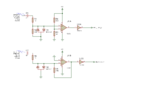cyber_dev
Junior Member level 1
Hi all,
I need to design a circuit to measure the frequency of sinusodial input signal. The max. input voltage is 50V RMS. The max. frequency of signal is 10 kHz.
In the schematic shown below there are two circuits for frequency measurement. I tried 2nd circuit with a sine wave over whole frequency range. It works well. But the min. input voltage should be greater than 500mV RMS for proper operation. (I didn't put the cap. in series). It will be better if I measure the frequency even in an amplitude level of 100mV RMS.
Which circuit do you suggest me to use? Is there a need for modification to improve safety and reliable operation? Thanks.

I need to design a circuit to measure the frequency of sinusodial input signal. The max. input voltage is 50V RMS. The max. frequency of signal is 10 kHz.
In the schematic shown below there are two circuits for frequency measurement. I tried 2nd circuit with a sine wave over whole frequency range. It works well. But the min. input voltage should be greater than 500mV RMS for proper operation. (I didn't put the cap. in series). It will be better if I measure the frequency even in an amplitude level of 100mV RMS.
Which circuit do you suggest me to use? Is there a need for modification to improve safety and reliable operation? Thanks.
